Jurassic Park is arguably one of the most iconic movie franchises of all time. The dinosaur-themed blockbuster is one of the significant reasons dinosaurs are so popular today.
Since the first movie in the franchise hit the big screens in 1993, numerous dinosaur species have been featured in it (some more popular than others).
Of course, Jurassic Park isn’t a science documentary, so not all information about the dinosaurs is accurate. Some dinosaur species were only created for the movies but didn’t exist in real life.
For those interested in learning more about these Mesozoic-era monsters, here are 7 of the most famous dinosaurs that have featured in the Jurassic Park movies.
Spinosaurus
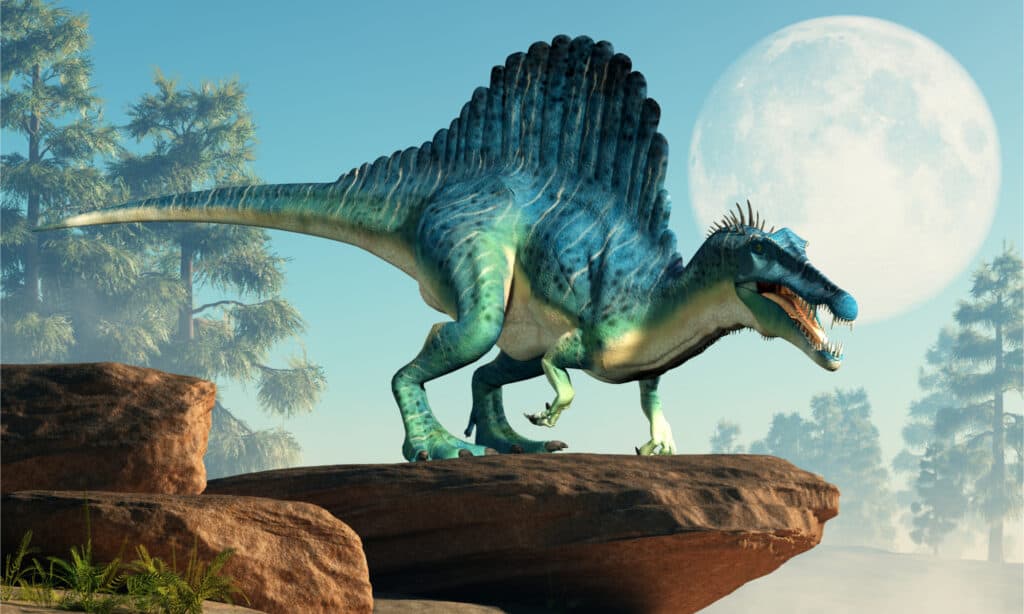
Spinosaurus is easily recognizable due to the spines on its back.
©Daniel Eskridge/Shutterstock.com
The Spinosaurus is hard to miss, thanks to the imposing spines it has on its back. This dinosaur species is the biggest of all flesh-eating dinosaurs. It is also one of the most famous dinosaurs on the big screen. According to experts, the Spinosaurus might have grown to heights of about 50 feet and was about 52 to 59 feet long. The estimated weight of this dinosaur species is between 7 to 9 metric tons.
Diet
Spinosaurus dinosaurs were carnivores. But they mostly hunted aquatic animals, which means their diet was composed mainly of fish. However, some scientists think they might have also hunted prey on land.
Habitat
Fossil evidence suggests that the Spinosaurus lived a semi-aquatic life, dividing its time between life on land and life in the water like modern-day crocodiles. They occupied humid environments on land, including prehistoric mangrove forests, tidal flats, other dinosaurs, turtles, crocodylomorphs, and plesiosaurs. The dinosaur’s leg had a high bone density, suggesting better buoyancy and control in the water. It also featured a paddle-like tail that most likely served the purpose of underwater propulsion.
Extinction
Fossil evidence shows that the Spinosaurus lived in North Africa during the late Cretaceous period. They most likely went extinct between 99 to 93.5 million years ago. The first fossil discovered was found in Egypt in 1912.
Carnotaurus
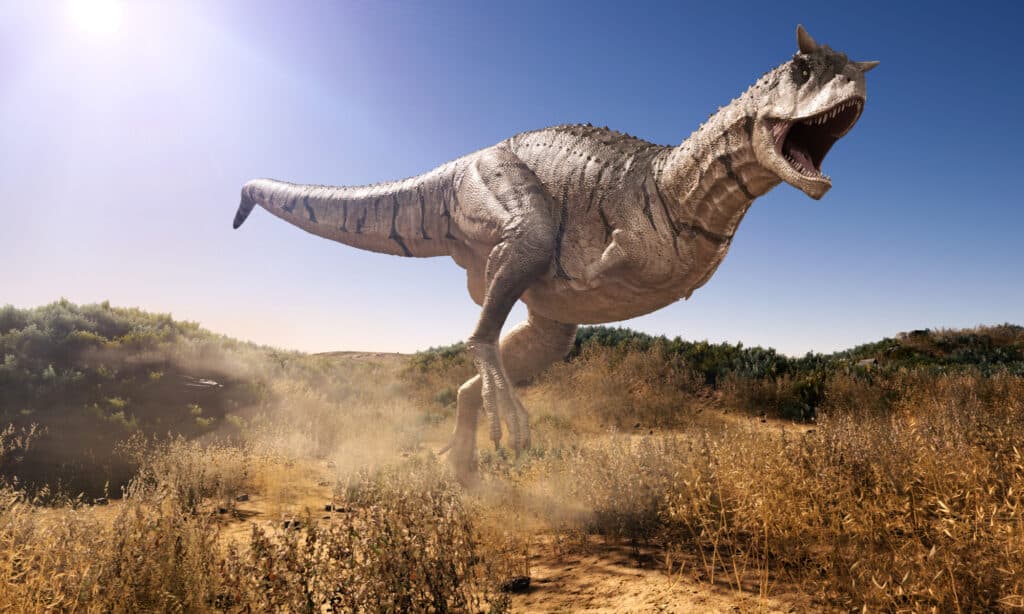
Carnotaurus had thick horns above its eyes, a deep skull, and a very muscular neck.
©Herschel Hoffmeyer/Shutterstock.com
The Carnotaurus dinosaurs were featured in Jurassic World: Camp Cretaceous and the Fallen Kingdom movies. The clones featured in the film looked slightly different from their real-life version. Carnotaurus is a theropod dinosaur that lived in the late Cretaceous period. It was lightly built, measuring about 8m in length, and might have weighed roughly 1.35 metric tons.
Some of the most notable features of this dinosaur include a thick horn above its eyes, a deep skull, and a very muscular neck. The Carnotaurus also featured small vestigial forelimbs (even smaller than that of the T-rex) and long hind limbs. From the fossil remains, there is evidence that this dinosaur has overlapping scales, interrupted by large bumps on its side, but it had no feathers.
Diet
It is unclear what the Carnotaurus dinosaurs fed on while roaming the earth. However, scientists suggest that the animal was a carnivore, capable of hunting down large prey and smaller animals alike. It most likely had a sharp smell of sense which it relied on to hunt for pretty because its sight and hearing were less developed. Despite its short forelimbs, the Carnotaurus most likely adapted to run very fast, and it was possibly one of the fastest large theropods.
Habitat
Scientists found Carnotaurus fossils in Argentina’s La Colonia formation. The paleoenvironment featured estuary habitats, coastal plains, and tidal flats. Also, as far as climates go, the area might have alternated between dry and humid climates during different periods. Cranotaurus probably shared the same habitat with turtles, Plesiosaurs, mammals, and other dinosaurs.
Extinction
The Carnotaurus dinosaurs lived between 71 to 69 million years ago. Paleontologists found the first fossil of this species in 1984, and it was a well-preserved, almost complete skeleton. The species disappeared during the mass extinction event that occurred 69 million years ago, along with the last of the dinosaurs.
Tyrannosaurus Rex
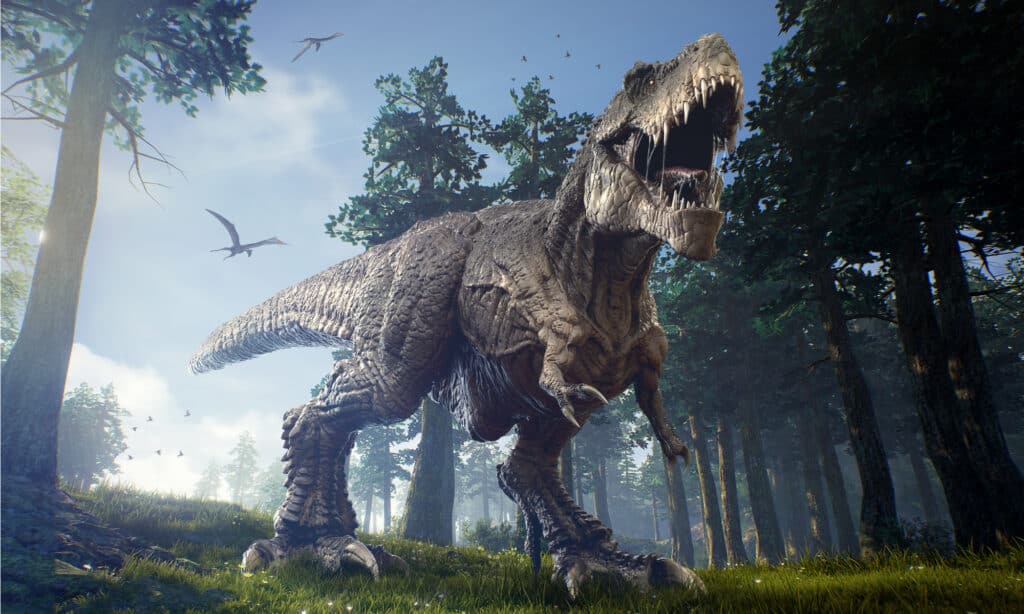
The hunting grounds of a Tyrannosaurus rex with two Quetzalcoatlus patrolling the skies in the background. Tyrannosaurus rex was the most ferocious predator to ever exist on earth.
©Herschel Hoffmeyer/Shutterstock.com
The Tyrannosaurus Rex (or T. Rex for short) is one of the most famous dinosaurs ever. It is the iconic mascot of the Jurassic Park franchise and one of the most terrifying dinosaurs in the movies and real life.
A bipedal carnivore, the T-rex had a massive skull with a long heavy tail. Although its short forelimbs are often a subject of memes today, they were pretty powerful for their size and featured sharp-clawed digits.
It had a bite force of more than 6 tons, making it one of the most powerful dinosaurs. Its jaws measured 1.4 meters and featured sharp, curved teeth. The Tyrannosaurus Rex was between 12 to 18 feet tall, which is about the size of your average house. It weighed 8 to 10 tons and was up to 42 feet.
Diet
The Tyrannosaurus was an apex predator of its time. It was the largest carnivorous dinosaur in the area it occupied, and it was an excellent predator thanks to its build and formidable features. Scientists believe this dinosaur might have preyed on other dinosaurs, including Hadrosaurids and Ceratopsids. Although the T-rex was undoubtedly a carnivore, experts aren’t sure how it hunted for meat. The most prevailing opinion is that it hunted prey. However, some believe that it might have been a scavenger.
Habitat
The Tyrannosaurus occupied the Western North American area on a separate prehistoric island known as Laramidia. It has a wide range, and most have occupied different types of habitats, including open forests and coastal swamps. The most preferred habitat of the T-rex was high humidity, semi-tropical areas.
Extinction
The ferocious Tyrannosaurus rex disappeared around 65 million years ago, along with several plants and animals that occupied the earth at the time as part of a global mass extinction event.
Mosasaurus
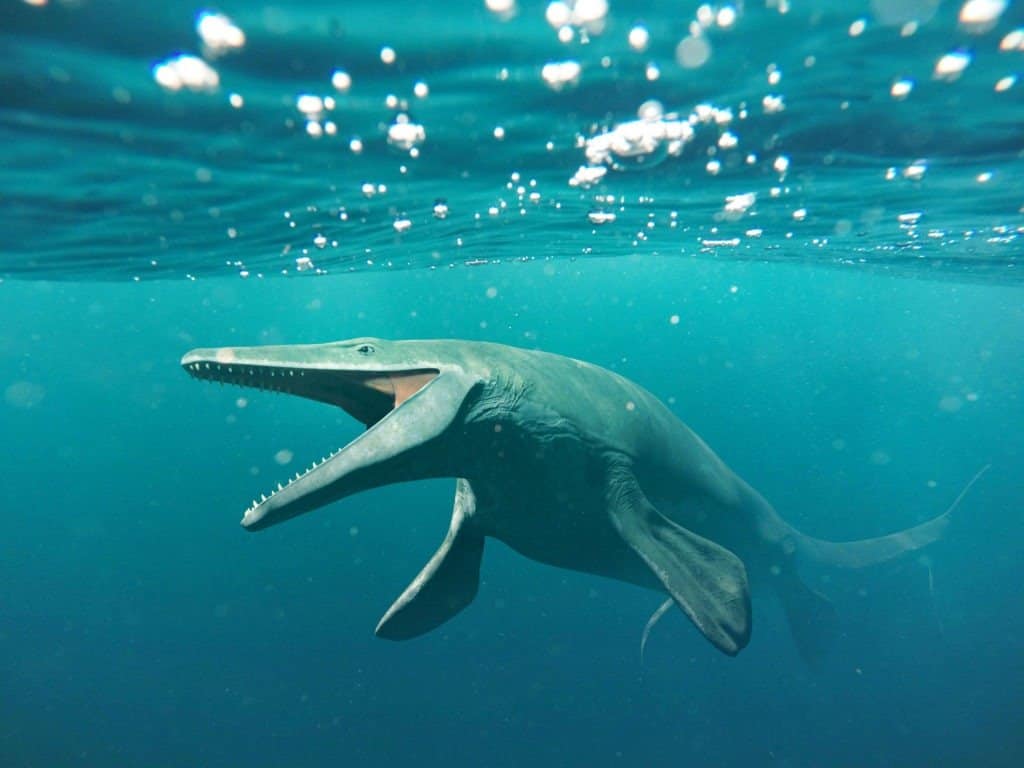
Mosasaurus lived more than 65 million years ago and grew up to 56 feet in length.
©Dotted Yeti/Shutterstock.com
The Mosasuarus was an aquatic mega-beast featured in the 2015 and 2018 Jurassic World movies. Undoubtedly one of the most famous dinosaurs from the franchise, the Mesosaurus, lived about 145 million years ago and might have been about 14 meters in length, making it one of the largest aquatic predators. Its skull featured massive jaws with strong muscles capable of delivering powerful bites and sharp teeth that could cut deep into prey.
Although it was an exclusively aquatic dinosaur, the Mosasaurus had four limbs shaped like paddles and used them for steering underwater. It also had a long time with a paddle-like fluke for propulsion.
Diet
Mosasaurus was a large ocean-dwelling predator that occupied the top of the food chain during its time. Given its massive size and formidable features, this predator could prey on pretty much any animal. Its diet might have included sea turtles, marine reptiles, and even other dinosaurs. In the Jurassic Park scene, it featured, the Mosasaurus was fed a 9-foot great white shark.
Habitat
The mosasaurs occupied the Atlantic Ocean and adjacent seaways during its time. Fossil distribution suggests that it occupied pretty much every continent except Australia, which means it was able to survive in a wide range of oceanic climates.
Extinction
The Cretaceous period was the height of the Mosasaurus’ dominance. Their extinction began as the global sea level dropped after the asteroid strike that killed the non-avian dinosaurs and other plant and animal species 65 million years ago. After the asteroid strike, their marine habitat collapsed, and the Mesosaurus could not survive.
Velociraptor
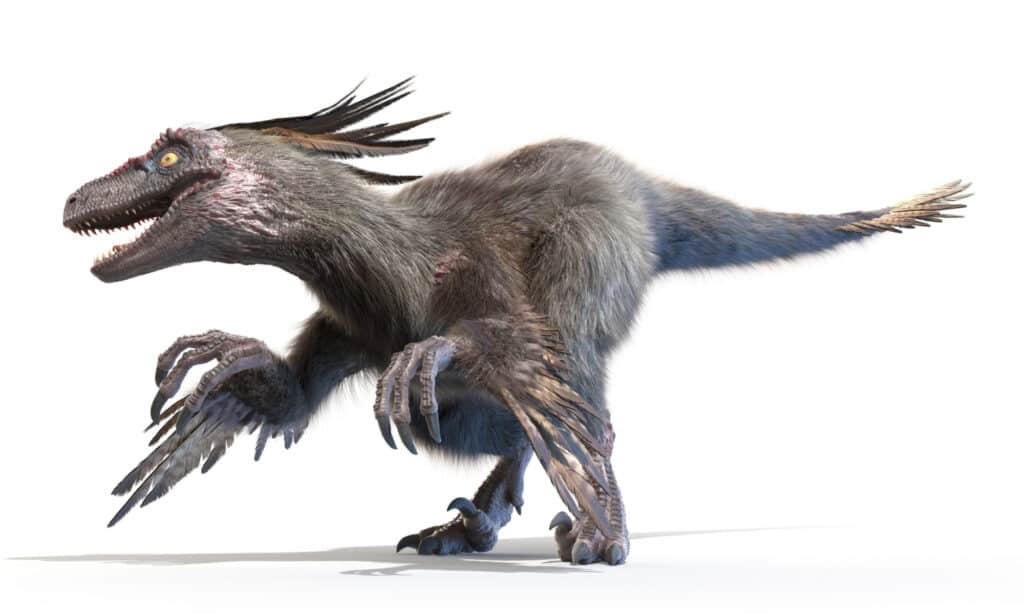
In the 1993 movie Jurrasic Park Velociraptors have no feathers, as their feathers were only discovered in 2007.
©SciePro/Shutterstock.com
The Velociraptor is more commonly referred to as “raptor” and is another dinosaur species that plays a prominent role in Jurassic Park movies. Blue, one of the most famous dinosaurs from the Jurassic World movie, and her sisters Delta, Echo, and Charlie are Velociraptors. Interestingly, the raptors are one of the dinosaurs whose appearance in the motion picture series differs significantly from how they looked in real life.
Real-life Velociraptors were roughly about the same size as a large turkey, with a height of just over 2 meters. They might have weighed about 180 pounds. Another notable difference was that they most likely had feathers. They were bipedal and had long tails with sickle-shaped claws on their feet.
Diet
Despite their relatively small size, raptors were ferocious predators which fed on other land animals. The movies depicted them as pack hunters. However, there is limited evidence to support this in real life. They might have hunted prey by chasing them and holding on to them with their sharp, curved claws like modern-day big cats do.
Habitat
Raptors occupied a desert-like environment with trees, shrubs, and some streams. Many Velociraptor fossils have been discovered in an area now known as the Gobi Desert in Southern Mongolia and parts of Northern China.
Extinction
The last trace of Velociraptor in the fossil record is about 70 million years ago. The reason for their extinction is unclear. They disappeared about five years before the mass extinction event that wiped out other non-avian dinosaurs.
Brachiosaurus

Brachiosaurus could reach plants that were as high as 30 feet off the ground thanks to their long necks.
©iStock.com/dottedhippo
The giraffe-like Brachiosaurus is another of the most famous dinosaurs from the Jurassic Park series with an unmistakable appearance. Its most notable feature is its disproportionately long neck and small skull. The Brachiosaurus lived 155.7 million to 150.8 million years ago, which means it is older than many of the other dinosaurs on this list.
It had an estimated length of 18 to 21 meters which means it was significantly larger than many of them. The Brachiosaurus might have weighed between 28.3 to 58 metric tons. Another notable feature of this dinosaur is the longer forelimbs and shorter hindlimbs, atypical of dinosaurs (most dinosaur species had short forelimbs). This gave the Brachiosaurus trunk a steeply inclined appearance.
Diet
The Brachiosaurus is one of the most popular non-flesh-eating dinosaurs. It had a ferocious diet and must have eaten from 440 to 880 lb of plant matter daily. It most likely fed on ginkgos, conifers, large cycads, and tree ferns. Considering its height, the dinosaur probably browsed foliage well above the ground.
Habitat
The presence of the Brachiosaurus fossil in the Morrison Formation of North America suggests that they occupied a semi-arid environment that transitioned between dry and wet seasons. It also had flat floodplains with a high vegetation population needed to support the Brachiosaurus. The Brachiosaurus probably lived alongside other dinosaurs such as Diplodocus, Barosaurus, andCamarasaurus.
Extinction
The Brachiosaurus dinosaurs lived between 156 million to 145 during the Jurassic period. This means they disappeared long before the extinction event 65 million years ago. Some scientists believe they might have lived into the cretaceous period.
Triceratops

Triceratops had a long bony frill with three horns on their skull.
©Dotted Yeti/Shutterstock.com
Triceratops are iconic dinosaurs with a remarkable appearance. Their most recognizable features include a long bony frill with three horns on their skull. They have a large, stocky body and share a convergent evolution with the rhinoceroses. They weighed as much as nine metric tons and were about 8 meters long. Aside from their motion picture appearance, many children’s toys and illustrations are made in the form of this gentle herbivore dinosaur.
Diet
Triceratops were herbivorous dinosaurs and given their short height and low-slung head, they must have fed on low-growing vegetation. It is also likely that they knocked down tall trees with their horns and hardened beak. They shared the same landscape with the T-rex, which means the ferocious predator most likely hunted them.
Habitat
Triceratops most likely lived in dry, forested areas or in plains with plentiful vegetation for them to eat. Their habitats must have had an abundant supply of palms, ferns, and cycads, their preferred food.
Extinction
The Triceratop dinosaurs went extinct during the Cretaceous–Paleogene extinction event, which occurred 6 million years ago, along with other non-avian dinosaurs.
Conclusion
These seven dinosaurs are among the most famous dinosaurs of all time. Even if you have never watched a Jurassic Park movie, chances are that you’ve seen pictures and illustrations of these ancient monsters at some point.
The photo featured at the top of this post is © iStock.com/para827
Thank you for reading! Have some feedback for us? Contact the AZ Animals editorial team.






